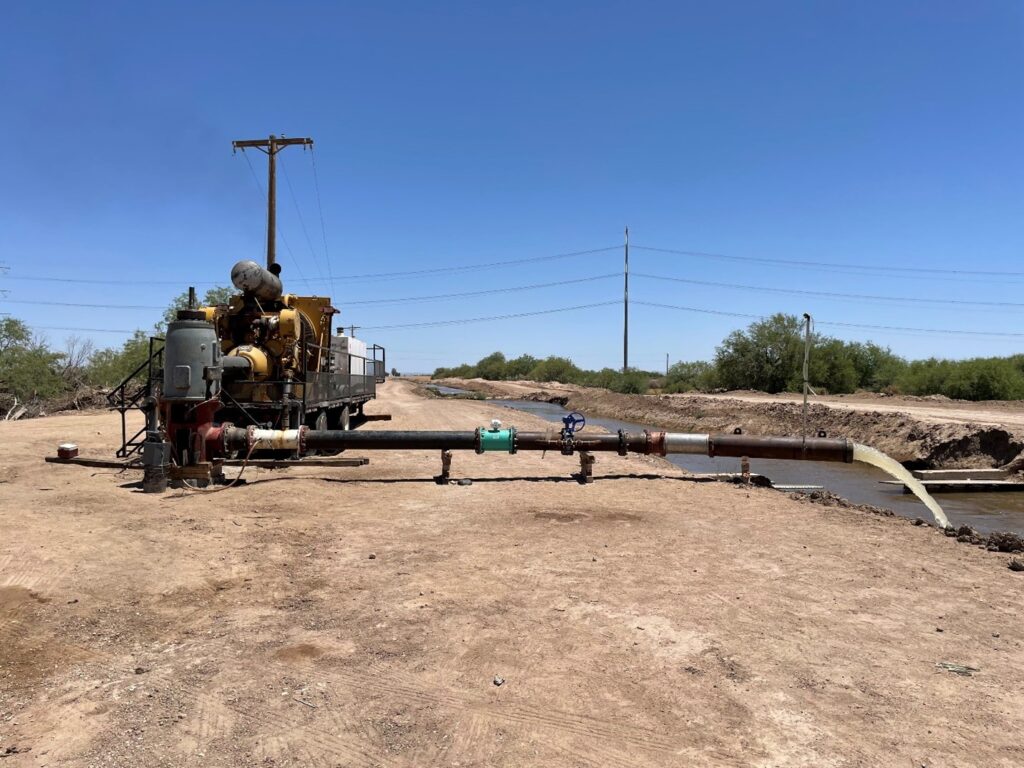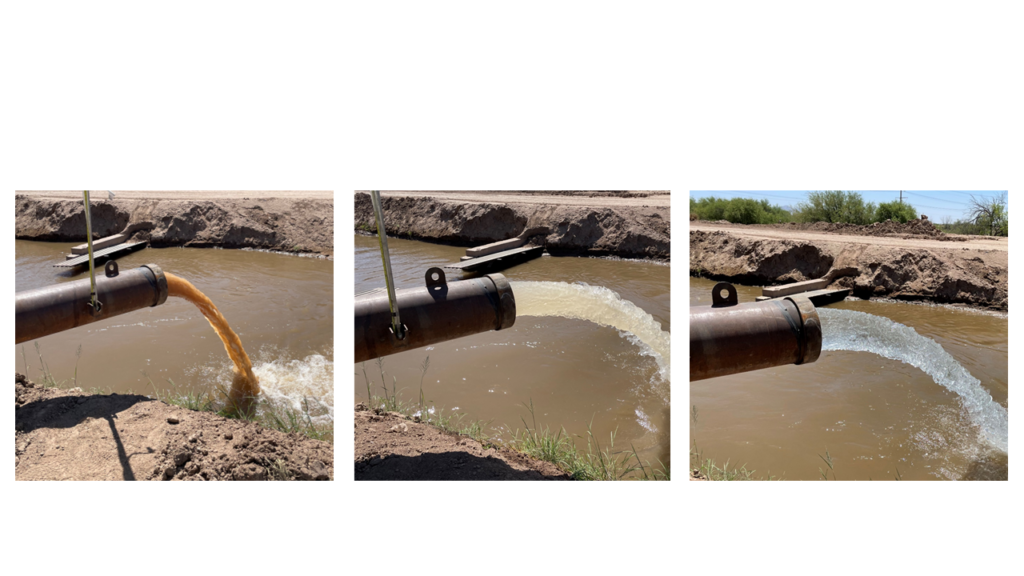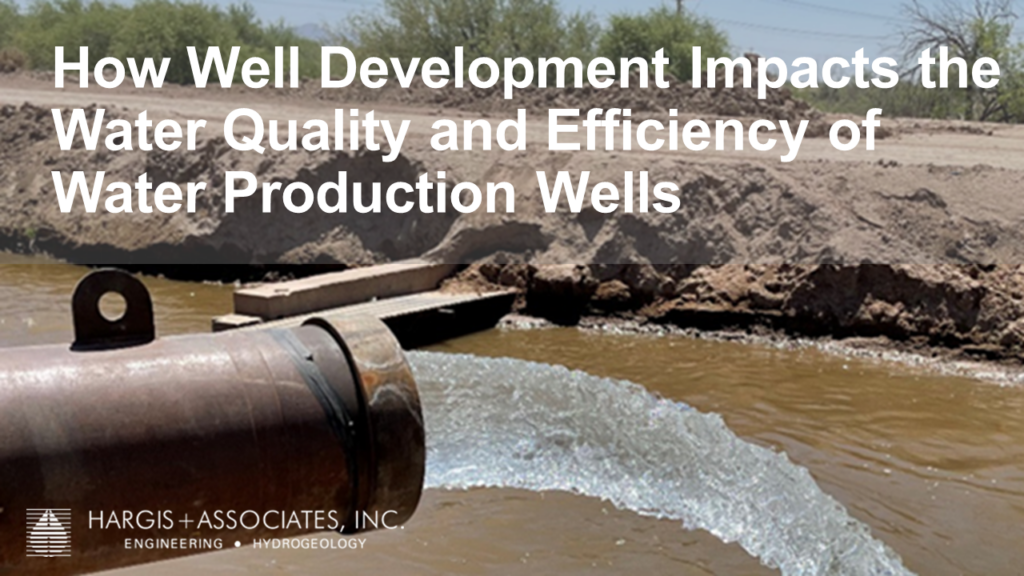Well development is a vital step in the process of installing a new well. It can be highly impactful on the water quality and pumping efficiency of the well. Whether installed for production or monitoring, having a well properly developed will help ensure the long-term health of the well. In this blog, I’ll cover the basics of water well installation and development.
Water Well Installation
Let’s start with a brief overview of the well installation process. To ensure the long-term, efficient productivity of a water well, a hydrogeologist will examine records or historical geophysical data of nearby wells to establish the optimal location and design of the new well. An optimal location for a well generally has high hydraulic conductivity and connectivity to an aquifer. The best geologic features for this are fractured consolidated materials or coarse unconsolidated materials.
Once the location is marked and necessary the permits are secured, well installation begins. The borehole is drilled using the proper technique for the geophysical conditions and the intended activities associated with the type the well. A hydrogeologist is on-site during drilling operations logging the lithological data. This will allow for a clear record of the geophysics in the borehole and aid in optimized well design. The hydrogeologist uses this data to place the well screen in the proper location, determine the screen slot size, and other crucial factors in designing an efficient well.
After the well has been designed based on the geophysical conditions discovered, the hydrogeologist works with the drillers to construct the well. This includes setting the well-casing, installing a gravel pack, and other necessary tasks. When done properly we will have constructed a well that could efficiently provide water for more than 50 years.
What is Well Development?
Well development is one of the last things necessary before a well becomes operational. It is the process through which a well is cleaned and conditioned to pump. The primary goal of development is to remove fine sediments from the well and to remove any contaminants introduced into the water column from the drilling process. Displacing these sediments creates more favorable conditions to achieve efficient pumping. After development, we will often see greater hydraulic conductivity and connectivity to the aquifer.
Hydrogeologists measure pumping efficiency in a variety of ways, but commonly specific capacity is used. This is measured by taking the pumping rate of a well and comparing it to the drawdown of the water column. The greater the specific capacity the more sustainable and efficient the well will be. This will lead to greater amounts of water being pumped and less energy needed to pump the water.
Water quality is also highly impacted by development. Sediments in water can be a problem in many instances, they can be high in metals or bacteria which can pose a problem for drinking water wells creating conditions not suitable for potable water.

Well Development Techniques
Development begins once the well construction is complete. Wells are developed to varying extents depending on the well owner’s needs and subsurface conditions. Maximum development is required for drinking water wells. Slightly less development is needed for agricultural wells. Environmental monitoring wells typically require the least amount of development.
Development techniques can be used in tandem or individually. Some of the most common include swabbing, airlifting, and pumping.
Swabbing and Airlifting
Swabbing is often the first method of development. Swabbing is the process of running a rubber swab down the well casing and around the well screen to force any material stuck to the casing into the water column where it can be more easily airlifted out.
Airlifting is the process of pumping air into the water column to displace the water and dislodge any sediment or drilling material that may be on the screen of the well. This process will be repeated along the length of the screen until the hydrogeologist achieves sufficient development. For some wells, the tandem of airlifting and swabbing may be enough to fully develop a well. But if there is still a significant volume of sediments and drilling material in the well, we may need to pump the well to further develop it.
Development Pumping
To develop a well using a pump, the pump is installed midway into the water column for surging. When surging a well, water is pumped at a steady rate to discharge water from the well the pump is shut off allowing the water level to stabilize. Then the pump is turned on again until the water reaches the surface, at which point the pump is turned off again. This cycle is repeated several times to loosen up any sediments or debris in the well before the pump is returned to a steady flow.
Measuring the amount of sediment coming from the discharge after surging and observing how quickly any turbidity fades from the discharge allows the hydrogeologist to identify how the development of the well is coming along. The process of surging the well can be repeated until the discharge water is clear and free of any turbidity. For wells requiring a lot of development, it may take more than 48 hours to achieve the desired level of development.  Development of a water production well using surge pumping. It may take more than 48 hours of pumping until the discharge water is free of turbidity.
Development of a water production well using surge pumping. It may take more than 48 hours of pumping until the discharge water is free of turbidity.
Pump Test
During the pump test, the well is pumped at different rates for an extended period. Hydrogeologists measure the drawdown of the well at each rate. Data from the pump test is used to determine the most efficient and sustainable pumping rate for the well. A pump test should always be conducted after well development is complete. Otherwise, inconsistent data may be collected, and the specific capacity of the well will be much lower than desired.
Steady Rate Test
A steady rate test is one of the final steps to getting a well up and running. Based on the results of the pump test, the well is pumped at the desired long-term rate for at least 12 hours. Like the pump test, the drawdown and pumping rate is monitored consistently. This data is then used in models to ensure that the well will be able to pump at that rate sustainably throughout the lifetime of the well.
Long-Term Water Well Efficiency
Once a well has been fully developed, discharge water should be completely clear and free of any sediment. This has great implications for the longevity of a well. Sediment-free water can be better used in all practices such as agriculture, drinking water, and environmental monitoring. It also reduces the risk of pump failure or other maintenance issues caused by excess sediments in the water. The development process conditions the well and the aquifer to allow for more efficient pumping, increased hydraulic conductivity, connectivity, and specific capacity.
In areas experiencing prolonged drought conditions, hydrogeologists ensure access to clean water. Groundwater exploration and development should be performed by experienced water professionals to maximize the life and productivity of your well.
If you’re considering new water well installation or would like an evaluation of your existing well’s performance, our team of experienced hydrogeologists can help. Connect with us at https://www.hargis.com/contact/
About the Author

Branden Selleh
Environmental Field Technician, Hydrogeologist
Hargis + Associates, Inc.
bselleh@hargis.com
https://www.linkedin.com/in/branden-selleh-67a17a180
Mr. Selleh has professional experience in hydrogeology and geology since 2021. Current professional responsibilities include performing routine groundwater and soil vapor monitoring at various sites across Arizona, report writing and data analysis, and database management for several EPA Superfund sites and other environmental projects. Mr. Selleh also has field experience in well drilling, lithologic logging, well construction, and well development.

